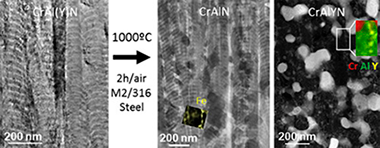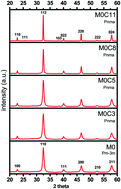Artículos SCI
2018
2018
Reactividad de Sólidos
Mesoporous Silica by Solution-Combustion Synthesis Followed by Etching
Salehtash, F; Jalaly, M; Motejadded Emrooz, HB; Gotor, FJ; Sayagués, MJInternational Journal of Self-Propagating High-Temperature Synthesis, 27 (2018) 221–227
Show abstract ▽
Mesoporous silica was synthesized through the solution-combustion process followed by etching with aqueous solution of sodium dodecyl sulfate (SDS). Combustion products were characterized by XRD, FTIR, SEM, TEM, HRTEM, and BET analysis. After etching, the specific surface, mean pore size, and volume of porous space in silica increased up to 390 m(2)/g, 15 nm, and 1.6 cm(3)/g, respectively. The synthesized mesoporous silica exhibited good performance in the tests on elimination of methylene blue from aqueous solution.
Octubre, 2018 | DOI: 10.3103/S1061386218040064
Tribología y Protección de Superficies
High-temperature oxidation of CrAlYN coatings: Implications of the presence of Y and type of steel
Rojas, TC; Dominguez-Meister, S; Brizuela, M; Sanchez-Lopez, JCSurface & Coatings Technology, 354 (2018) 203-2013
Show abstract ▽

Nanolayered CrAIN and CrAIYN/CrAIN (average contents of Al approximate to 25 at.% and Y approximate to 1.6 at. %) coatings are deposited on M2 and 316 steel substrates and heated to 1000 degrees C in air for 2 h to study their oxidation mechanism, the thermal stability and the reactive element (RE) effect of yttrium. CrAIN on M2 develops a Cr2O3/Al2O3 passivation layer that preserves in high degree the fcc-CrAIN structure however iron ions leave the substrate and travel to the surface along the column boundaries. The CrAIYN/CrAIN coatings deposited on steels are not stable at 1000 degrees C, and the initial fcc-CrAIN phase is partially transformed to hcp-Al(O)N and Cr-Fe phases (M2) and Cr2N and Al2O3 (316). The addition of Y changes the predominant scale growth direction. Inward oxygen diffusion becomes dominant but a reduction of the oxide scale thickness as compared to CrAIN is not observed. The advanced microstructural analysis made by transmission electron microscopy combined with electron energy loss spectroscopy determined that yttrium migrates mainly to the oxide scale (forming mixed oxides with substrate elements - V and Mo, either as dispersed particles or segregated at the grain boundaries) in M2, and to the oxide interface and column boundaries (forming Al-Y oxides and YN, respectively) in 316 steel. The benefits of addition of Y in improving the oxidation resistance are discussed comparatively with literature data. The RE effect of yttrium is thus observed to be dependent on the substrate, film architecture and composition.
Octubre, 2018 | DOI: 10.1016/j.surfcoat.2018.09.020
Reactividad de Sólidos
Study of the thermal decomposition of historical metal threads
Perez-Rodriguez, JL; Perez-Maqueda, R; Franquelo, ML; Duran, AJournal of Thermal Analysis and Calorimetry, 134 (2018) 15-22
Show abstract ▽

In this work, it is reported that thermal analysis techniques such as differential thermal analysis and thermogravimetric analysis are very useful for evaluating metals threads and fibres used in the manufacture of historical artifacts. Thermal analysis has been used to characterize the silk, cotton and linen employed as supports and the copper, silver and aluminium as the metallic components in the studied threads. Other organic compounds, mainly added for the conservation of the threads, have also been characterized.
Octubre, 2018 | DOI: 10.1007/s10973-017-6924-x
Fotocatálisis Heterogénea: Aplicaciones
Photocatalytic H2 production from glycerol aqueous solutions over fluorinated Pt-TiO2 with high {001} facet exposure
V. Vaiano; M.A. Lara; G. Iervolino; M. Matarangolo; J.A. Navío; M.C. HidalgoJournal of Photochemistry and Photobiology A-Chemistry, 365 (2018) 52-59
Show abstract ▽

An optimized fluorinated TiO2 catalyst with high {001} facet exposure loaded with platinum (TiO2-PtFAC) was tested in the photocatalytic hydrogen production from glycerol solution under UV light irradiation. The samples were synthesized by direct hydrothermal treatment starting from two different types of precursors that are titanium tetraisopropoxide (I) or titanium butoxide (B), while platinisation was performed by photodeposition method. The obtained catalysts were characterised by different techniques (XRD, FESEM, TEM, BET, UV–vis DRS, XRF and XPS) and the results evidenced that anatase is the only crystalline phase present in all TiO2 samples. The morphology of the samples was seen as rectangular platelets particles where Pt particles were was observed all over the surface. The presence of Pt and F in the platinised samples was also confirmed by XRF and XPS analysis. The photocatalytic results have shown that the presence of Pt on TiO2{001}facet surface remarkably enhanced the hydrogen production from aqueous solution at 5 wt % of glycerol. Comparing the results obtained from the photocatalysts prepared by the two different precursors, it was found that the best performances in terms of H2 production was achieved with TiO2-PtFAC(I) (about 13 mmol L−1 after 4 h of irradiation time), while the H2 production was lower for TiO2-PtFAC(B) (about 9 mmol L−1 after 4 h of irradiation time). The effect of the operating conditions using TiO2-PtFAC(I) evidenced that the highest H2 production was obtained with a photocatalyst dosage equal to 1.5 g L−1, initial glycerol concentration at 5 wt% and a pH value equal to 7. Finally, a photocatalytic test was also performed on glycerol solution prepared with a real water matrix. Despite the presence of ions scavengers (chlorides and carbonates) in solution, TiO2-PtFAC(I) was able to reach a photocatalytic H2production of about 6 mmol L−1 after 4 h of UV light irradiation.
Octubre, 2018 | DOI: 10.1016/j.jphotochem.2018.07.032
Reactividad de Sólidos
Isosymmetric structural phase transition of the orthorhombic lanthanum gallate structure as a function of temperature determined by Rietveld analysis
Tang, Y. Q.; Lopez-Cartes, C.; Aviles, M. A.; Cordoba, J. M.CRYSTENGCOMM, 20 (2018) 5562-5569
Show abstract ▽

High energy planetary ball milling has been used to synthesize pseudo-cubic highly-pure LaGaO3 in one hour from its oxide components in an air atmosphere. Calcination at different temperatures led to the crystallization of lanthanum gallate in an orthorhombic structure with its local lanthanum coordination number environment changing from 12 to 7 when the temperature was increased. This change was attributed to the thermal expansion of the Ga-O bonds that varied non-monotonically inducing GaO6 tilting. Rietveld analysis, Raman spectroscopy, and transmission electron microscopy were used to elucidate the LaGaO3 structures at different temperatures.
Octubre, 2018 | DOI: 10.1039/c8ce00726h
- ‹ anterior
- 154 of 420
- siguiente ›














